

Now more than ever, it's vital that we learn where how to use this legally, without infringing on the rights of the content owners. Technology is an amazing tool that should be used to teach and inspire, but only when it's done within the confines of the law.
Teachers and students need to be made aware of the proper use of technology and the ramifications of misuse, or copyright infringement. Some content is usable under the Fair Use law, but it's complicated. The following information will teach you what you need to know. However, the information on this page is to be used as a guide only - it is not meant to be legal advice.
Home. Copyright Copyright is a legal right created by law that gives the creator of an original work exclusive rights to its use and education.

Copy protection exists from the moment a work is created. US court rules that using online photos can be considered 'fair use' Center for Media & Social Impact. Download 100,000 Royalty-Free Music, Sound Effects, and Loops. Copyright and Fair Use Tagul. U.S. Copyright Office.
K-12 Digital Citizenship Curriculum. What is Copyright? - YouTube Help. Creative Commons. Taking the Mystery Out of Copyright. Skip navigation Library of Congress Teachers Suggestions enabled.
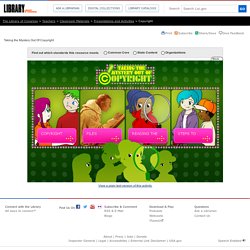
The Library of Congress > Teachers > Classroom Materials > Presentations and Activities > Copyright Print Subscribe Share/Save Give Feedback Taking the Mystery Out Of Copyright View a plain text version of this activity. Connect with the Library All ways to connect Find Us On Subscribe & Comment Download & Play Questions About | Press | Jobs | Donate Inspector General | Legal | Accessibility | External Link Disclaimer | USA.gov Speech Enabled. Fair Use - Center for Media and Social Impact. Copyright and Primary Sources.
How do I use the Restriction Statements that accompany the American Memory collections?
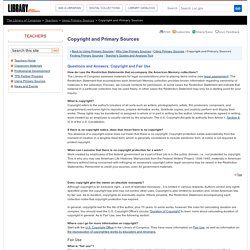
The Library of Congress assesses materials for legal considerations prior to placing items online (see legal assessment). The Restriction Statement that accompanies each American Memory collection provides known information regarding ownership of materials in the collection. If known, we include contacts for permission. In some cases the Restriction Statement will indicate that material in a particular collection may be used freely; in other cases the Restriction Statement may only be a starting point for your inquiry. Teaching Copyright. As today's tech-savvy teens become increasingly involved with technology and the Internet for learning, work, civic engagement, and entertainment, it is vital to ensure that they understand their legal rights and responsibilities under copyright law and also how the law affects creativity and innovation.

This curriculum is designed to give teachers a comprehensive set of tools to educate students about copyright while incorporating activities that exercise a variety of learning skills. Lesson topics include: the history of copyright law; the relationship between copyright and innovation; fair use and its relationship to remix culture; peer-to-peer file sharing; and the interests of the stakeholders that ultimately affect how copyright is interpreted by copyright owners, consumers, courts, lawmakers, and technology innovators. Unit Goals. Public Domain Collections: Free to Share & Reuse.
That means everyone has the freedom to enjoy and reuse these materials in almost limitless ways.
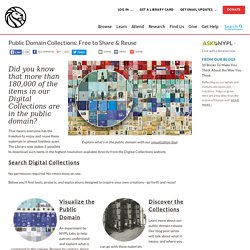
The Library now makes it possible to download such items in the highest resolution available directly from the Digital Collections website. Search Digital Collections No permission required. No restrictions on use. How to Blog Legally. One of the many wonderful things about blogging is that you don’t need any previous experience or education to do it.
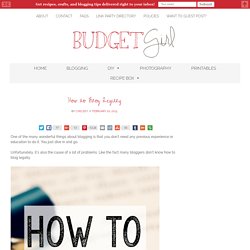
You just dive in and go. Unfortunately, it’s also the cause of a lot of problems. Like the fact many bloggers don’t know how to blog legally. Copyright Librarian – Nancy Sims, Lawyerbrarian at large. Created for Learning: When can I use someone else's images in my resources? We were lucky enough that a connection of ours landed us a free chat with a big trademark/copyright attorney in Southern California.
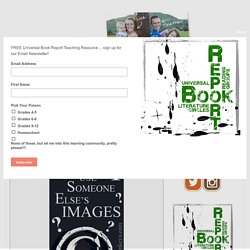
We talked about these things with him. We learned that you can use images from films as long as... you create your own derivative work...and/or...you only use as much as you reasonably need to use...and/or...you do not use critical/spoiler portions of the creative work...and/or...you don't compete with their intended market...and/or...you use it in instructive and not decorative ways.ACCEPTABLE USE: Example: Someone could create a Powerpoint that includes short video clips from films for the class to discuss the use of lighting or sound editing or character motives or etc.Example: Someone could use multiple small quotes from the text.Example: Someone could start with someone else's artwork and transform it drastically enough that it is no longer that work or in competition with that work.
[as in the Landmark Copyright Lawsuit Cariou v. Can I Use that Picture? The Terms, Laws, and Ethics for Using Copyrighted Images – The Visual Communication Guy: Design, Writing, and Teaching Resources All in One Place! Need to use an image but not sure if you have the legal and ethical right to do so?

Understanding the laws for using images can be a bit tricky, especially because there is wiggle room within the laws. And, with the mass distribution of images on the internet, it’s no wonder we’re all asking the the same question over and over again: can I use that picture? Day at School: Copyright and You. Copyright and Fair Use for Student Projects. Code of Best Practices - National Movment. Fair Use Principles. Copyright, What's Copyright? Copyright Awareness for Students (3 minute video) Copyright School. Copyright and Fair Use: Education, Digital Media, and Beyond - Live Workshop Archive. CopyRIGHT and FAIRuse for Educators. Nicole's Story - Copyrighting Creative Work. A Fair(y) Use Tale. Copyright Education User Rights, Section 107 Music Video. Fair Use for Media Literacy Education.
Renee Hobbs - Copyright Clarity: How Fair Use Supports Digital Learning. How Not to Make a Documentary. Copyright, Exceptions, and Fair Use: Crash Course Intellectual Property #3. Teacher's Guide to Digital Citizenship. The horror stories of young people not grasping the reach and influence of the content they put online are familiar to all of us.
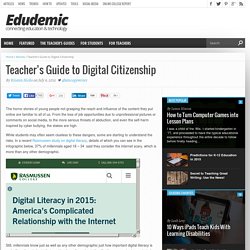
From the loss of job opportunities due to unprofessional pictures or comments on social media, to the more serious threats of abduction, and even the self-harm inspired by cyber bullying, the stakes are high. While students may often seem clueless to these dangers, some are starting to understand the risks. In a recent Rasmussen study on digital literacy, details of which you can see in the infographic below, 37% of millennials aged 18 – 34 said they consider the internet scary, which is more than any other demographic.
Still, millennials know just as well as any other demographic just how important digital literacy is and will continue to be to their working lives. As such, studies like these serve to demonstrate how crucial teaching digital literacy — particularly at a young age when that digital footprint is still lightly drawn — has become. Online Safety. Opening Gates On Celebrating Creative Commons and Flexing the Fair Use Muscle. Copyright: Will We Always Be Behind the Times? I dusted off my copyright presentation the other day, getting ready to talk to a journalism class full of juniors.
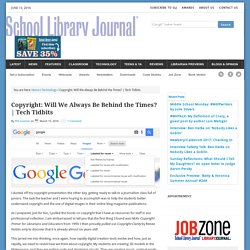
The task the teacher and I were hoping to accomplish was to help the students better understand copyright and the use of digital images in their online blog magazine publications. As I prepared, just for fun, I pulled the books on copyright that I have as resources for staff in our professional collection. I am embarrassed to tell you that the first thing I found was NEA’s Copyright Primer for Librarians and Educators from 1995! I then proudly pulled out Copyright Clarity by Renee Hobbs only to discover that it is already almost six years old! This jarred me into thinking, once again, how rapidly digital creation tools evolve and how, just as rapidly, we need to revisit how we think about copyright. I know our students need the tools and knowledge to critically question and consider how works they create or use dramatically impact others. “Is everything copyrighted?” 3-D Printers: Understanding Copyright, Fair Use, and More.
Libraries have been on the front lines of the digital revolution since its beginning. 3-D printing is the latest wave of this revolution, which continues to fundamentally change the way we access, process, and produce information. This technology brings digitization to the physical marketplace for the first time, by allowing people of all ages to use digital processes to create tangible items that can be used, traded, bought and sold. It promises progress across numerous industries and sectors. The burgeoning field of “bioprinting”—the printing of human organs—creates new opportunities for medical research; the use of 3-D printing in defense manufacturing enhances U.S. national security by allowing for the more efficient production and delivery of intricate items used by the military; and the successful deployment of 3-D printing technology to outer space heralds a day when thousands of miles and a lack of gravity no longer constrain the delivery of supplies to astronauts.
Copyright and Primary Sources. The Educator's Guide to Copyright and Fair Use. A five-part series When it comes to copyright law and the application of fair use exceptions, ignorance is definitely not bliss! Learn how to educate yourselves and your students and avoid making a costly mistake! You really did plan to find time over the summer to familiarize yourself with the latest information on copyright law. You absolutely intended to look up the fair use guidelines for using technology resources.
After 10 Years, Google Books Is Legal. On Friday, a federal circuit court made clear that Google Books is legal. A three-judge panel on the Second Circuit ruled decisively for the software giant against the Authors Guild, a professional group of published writers which had alleged Google’s scanning of library books and displaying of free “snippets” online violated its members’s copyright.
To some digital-rights followers, the Google Books case had seemed to drag on forever: The Authors Guild first filed suit 10 years ago. But the theory behind the eventual ruling was a quarter-century in the making. In 1990, a district-court judge named Pierre Leval published an article in the Harvard Law Review proposing a new theory of fair use.
In fact, the article was named “Toward a Fair Use Standard.” Morguefile.com free stock photos. High Quality Royalty Free Stock Photos, Royalty free Images. Picdrome Public Domain Copyright-Free Pictures. PhotoPin - Free Photos for Bloggers via Creative Commons. CC Search. Commons. Over 388,494 Free Photos and Textures. Free Music Archive. Purple Planet Royalty Free Music. Netlabels : Free Music : Free Audio : Download & Streaming.
By Clinical Archives "CLINICAL ARCHIVES IS ABOUT EXPANDING THE DEFINITION OF MUSIC" This is independent netlabel for eclectic and illogical music. The basic directions : abstract, avant-garde, alternative, indie, intuitive improvisation, free improv, jazz, fusion, electronic jazz, free jazz, funk, jam band, live electronic, experimental, experimental pop, dark disco, contemporary, manipulation, neo-classicism, illbient, ambient, musique concrète, noise, tape music, minimalism, acousmatic music, sound...
Topic: Clinical Archives Sirona is an underground netlabel based in France. Sirona was etablished in order to promote & release wide ranges of electronically developed music made by artists from artists from all around the globe. Welcome to Dusted Wax Kingdom - a netlabel based in Varna (Bulgaria). By Torn Flesh Records EXPLORE Torn Flesh Records CATALOG Welcome to Torn Flesh Records - Netlabel. By Comfort Stand by Monotonik by Bump Foot Bump Foot is a non-profit netlabel. Free Sound Clips.
Download & Streaming : Moving Image Archive. Movies eye favorite 2. Classic Cat - the free classical music directory.